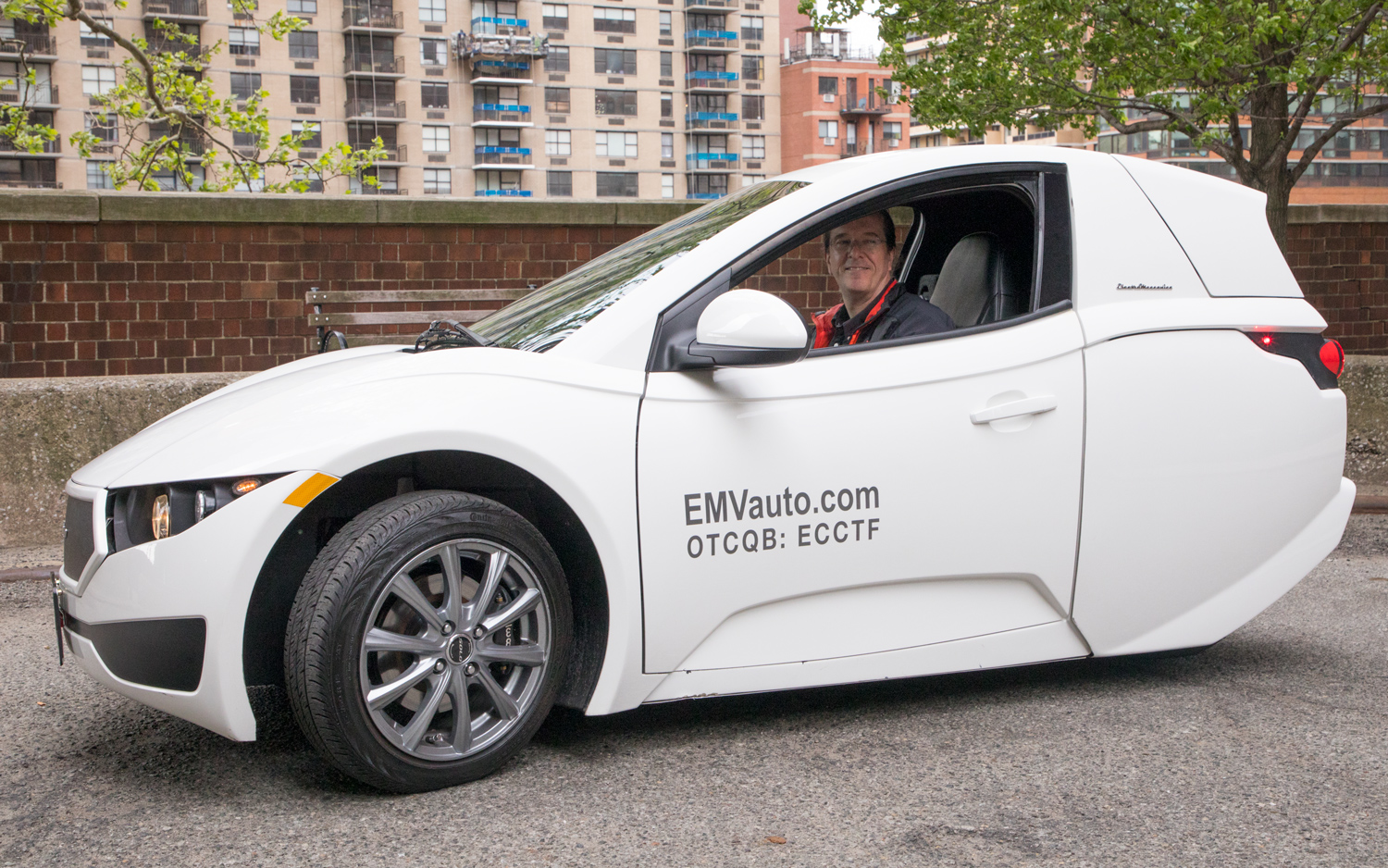Tom's Guide Verdict
The all-electric Solo three-wheeler deserves praise for innovation and offering commuters a fun way to mitigate the daily grind of getting to work.
Pros
- +
Fun to drive
- +
100-mile electric range
- +
Attention-getting design
Cons
- -
Single-seater
- -
Firm ride
- -
No rearview mirror
Why you can trust Tom's Guide
A woman driving a Mister Softee truck zigzagged across multiple lanes of traffic to follow me and shoot video as I drove down Second Avenue. Several drivers rolled down their windows to shout out questions. A livery driver offered to swap his brand-new Mercedes-Benz S-Class for my car. And so many other drivers either stopped and blocked traffic, or were distracted by the sight of my test vehicle, that I worried I was going to cause an accident.
Such is the attention you can expect to receive behind the wheel of Electra Meccanica's Solo, a $15,500 three-wheeled electric vehicle (EV) created for commuters.
The single-seater may look odd, but it is street legal. Vancouver, British Columbia-based Electra recently received certification for the vehicle in the U.S. so that you don't need a special license to drive it. The first Solo was delivered to a U.S. customer in May, and I had a chance to test out a preproduction model to assess its capabilities.
Design: An EV built for one
Although the Solo is about two-thirds the width of a regular sedan, the snout of the vehicle looks like that of a traditional car, with dual headlights and a swept-back hood and windscreen. It's when you walk around the vehicle that you realize something's missing — namely, a rear seat and one of the wheels. Instead, the car tapers back to a single wheel.
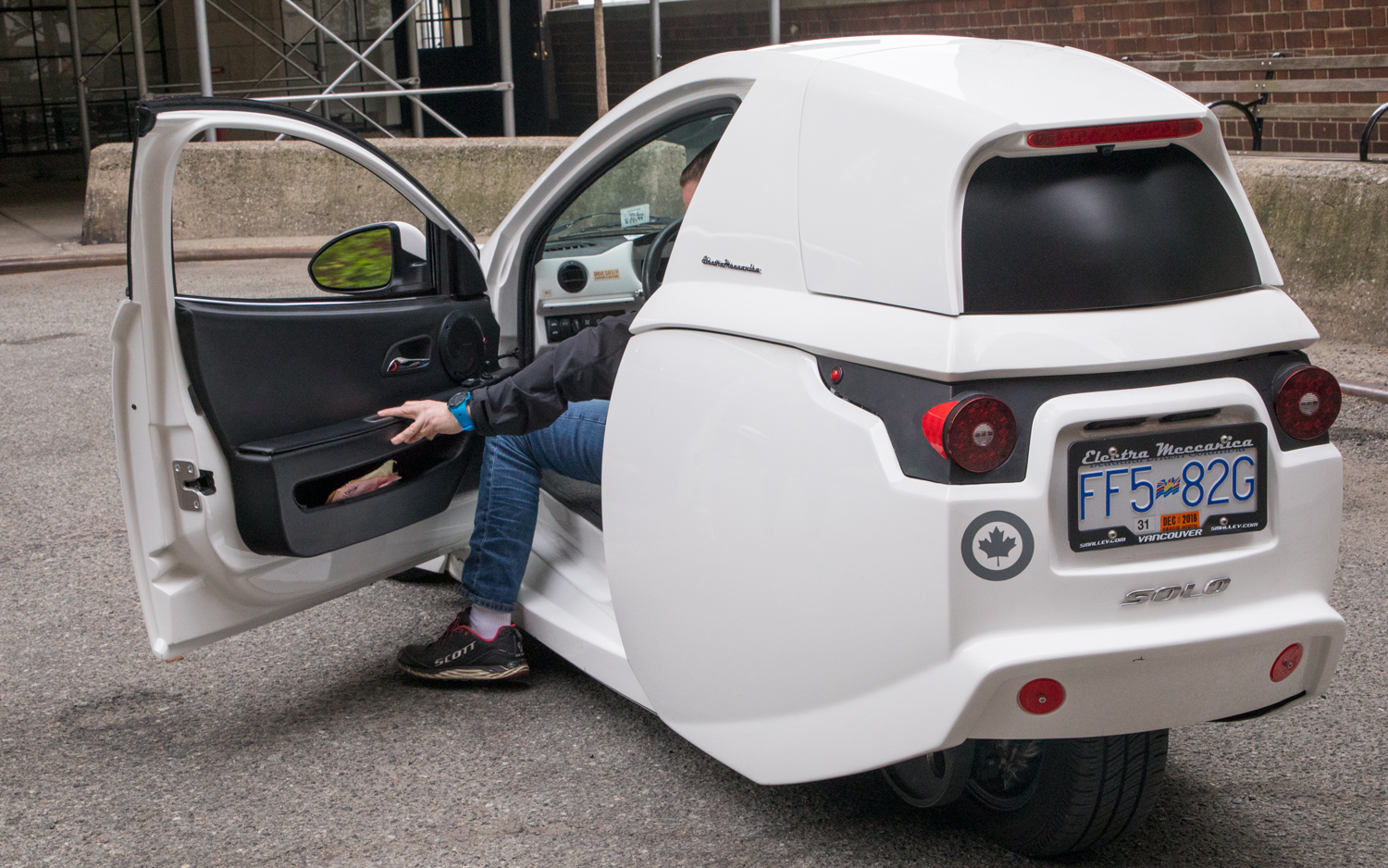
One smart aleck who stopped to gawk said it looked like a regular car that had been squished in an accident. Indeed, you can fit five Solos into two conventional parking spaces.
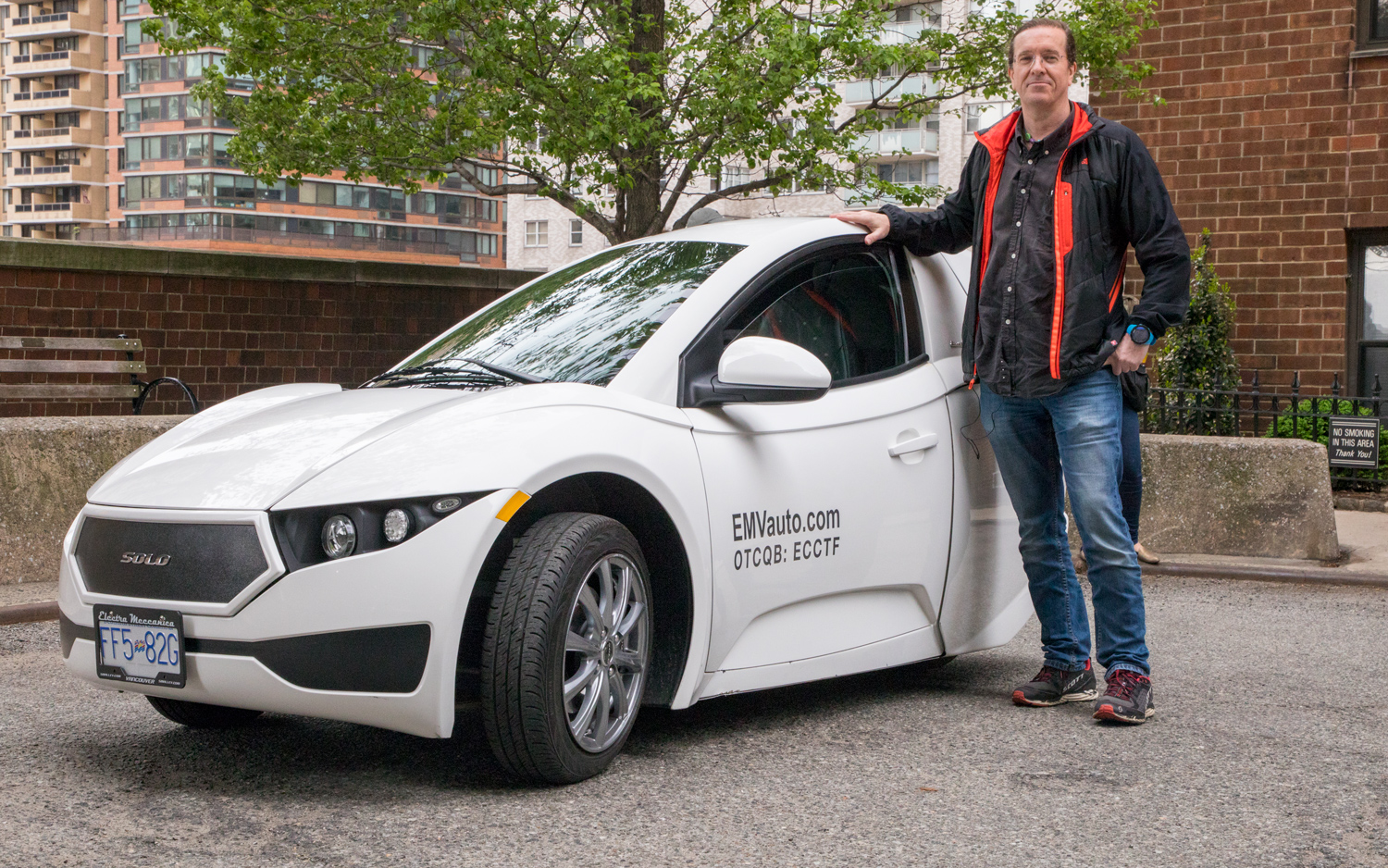
An unusual feature of the single-seater is that it has doors on each side, so you can get in and out on either the left or the right (a handy option should you find yourself in a tight spot). There are two smallish trunks — one on the front, and one on the back. Combined, there's room for a few bags of groceries and a couple of carry-on-size pieces of luggage.
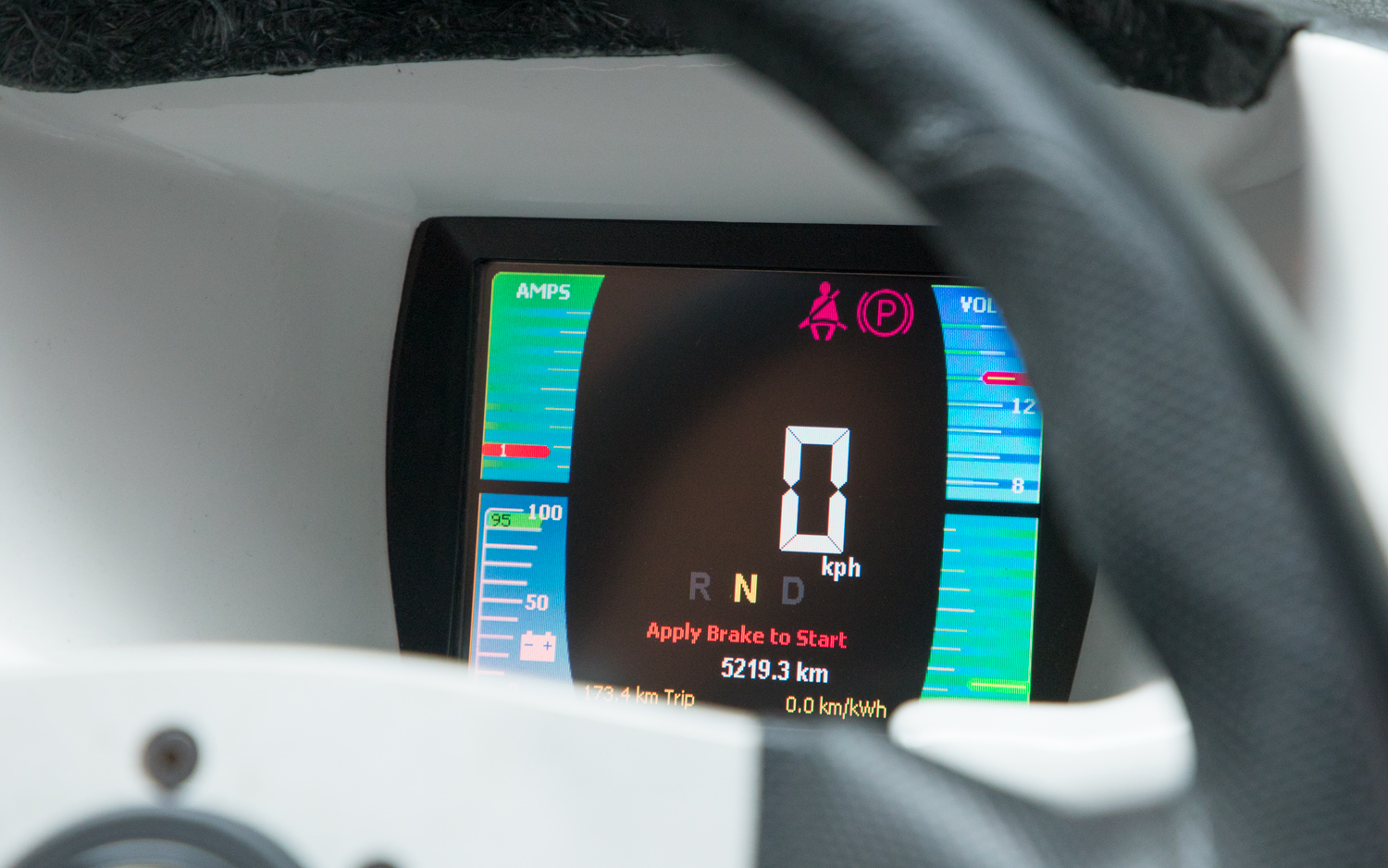
There's no rearview mirror. (In fact, there's no rear window.) The two side mirrors cover everything you'll need to see behind you, and there's a backup video camera whose view shows up on the center display when you put the car into reverse.
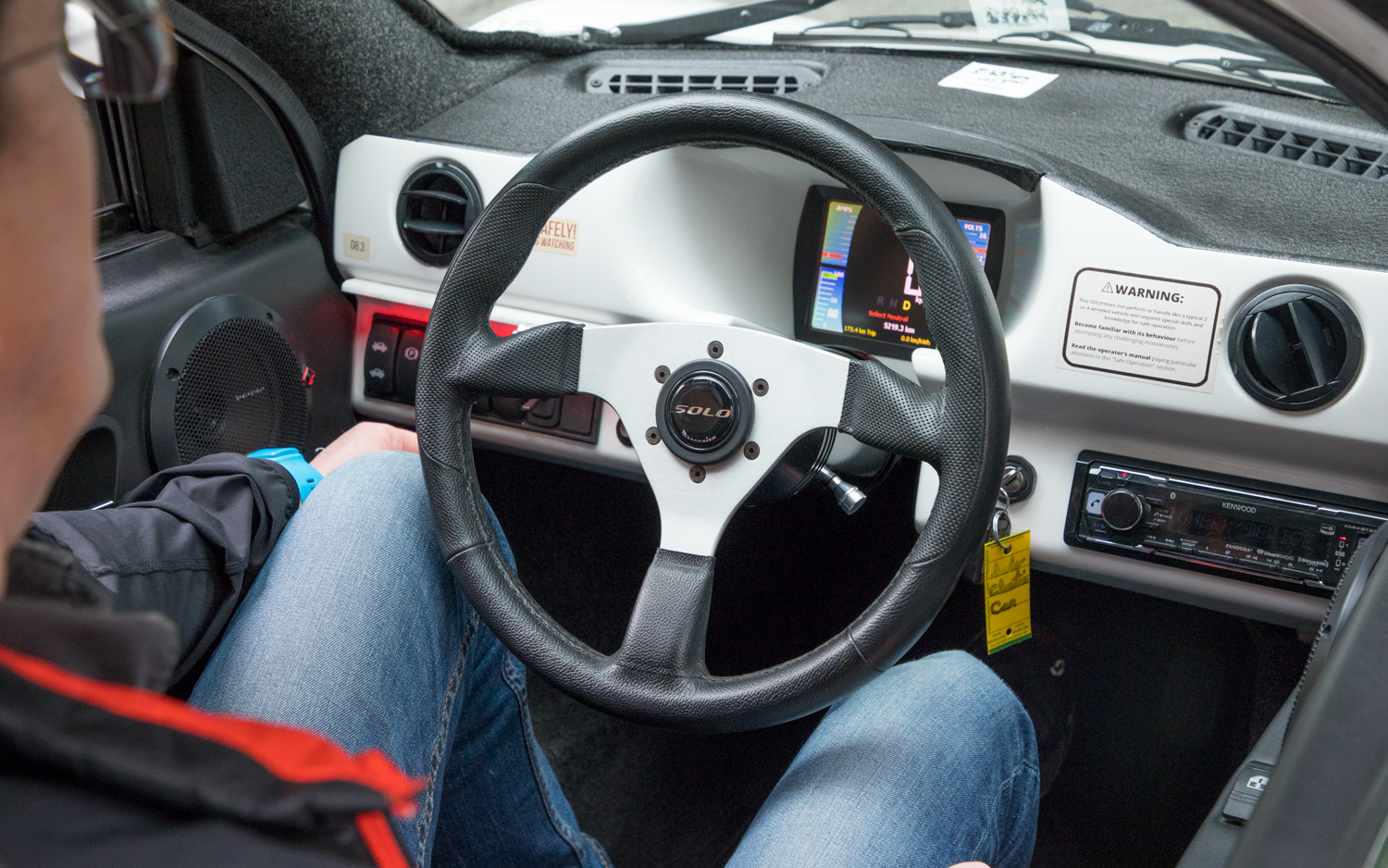
The Solo offers many features you'd expect in a conventional vehicle. It has an LCD instrument cluster, a rearview backup camera, power windows and an AM/FM stereo with Bluetooth for hands-free calling. However, there's no built-in navigation system or support for Apple CarPlay or Android Auto.
Electra Meccanica 2018 Solo: Key Specs
Price as Tested: $15,500 MSRP
EV Range: 100 miles
Connected Car System: Bluetooth connectivity for hands-free calling
Top Speed: 82 mph
0 to 60 mph: 8 seconds
Engine and Drivetrain: 82-hp AC synchronous electric motor, rear-wheel belt drive with a 17.3-kWh lithium-ion battery
The Power Tech: Basic necessities
The Solo is powered by a 17.3-kWh lithium-ion battery that delivers a driving range of up to 100 miles. It can use 220- or 110-volt charging via a J1772 port concealed under the rear license plate. With a 220-volt outlet, it takes about 3 hours to fully charge the car; using a standard 110-volt household outlet, it takes about 6 hours.
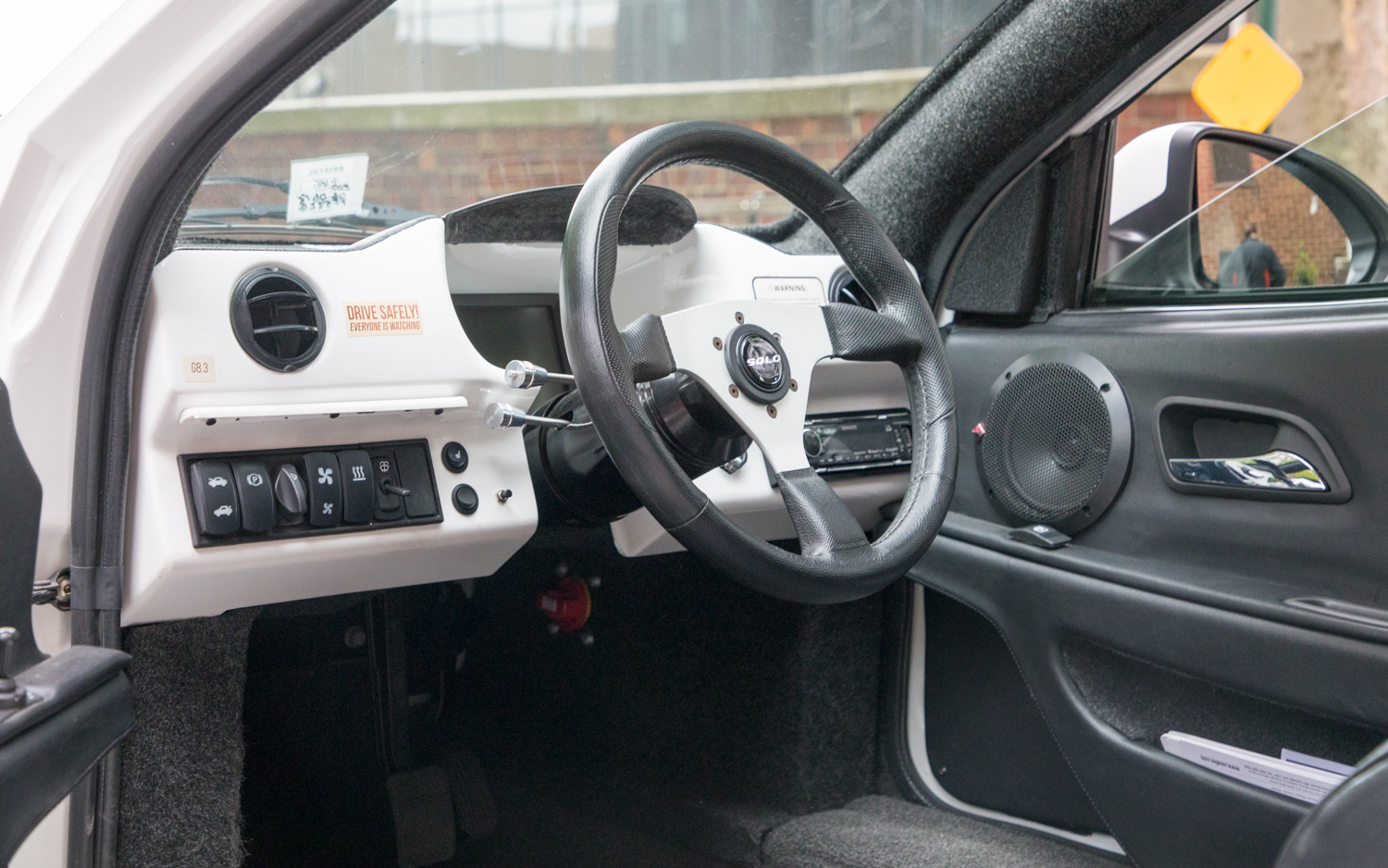
The rear-wheel-drive car uses an 82-hp AC synchronous electric motor; A carbon-fiber belt turns the rear wheel, and there's no shifting. The Solo, which uses 15-inch wheels, is constructed using aluminum honeycomb and composite materials to keep the weight under 1,500 pounds.
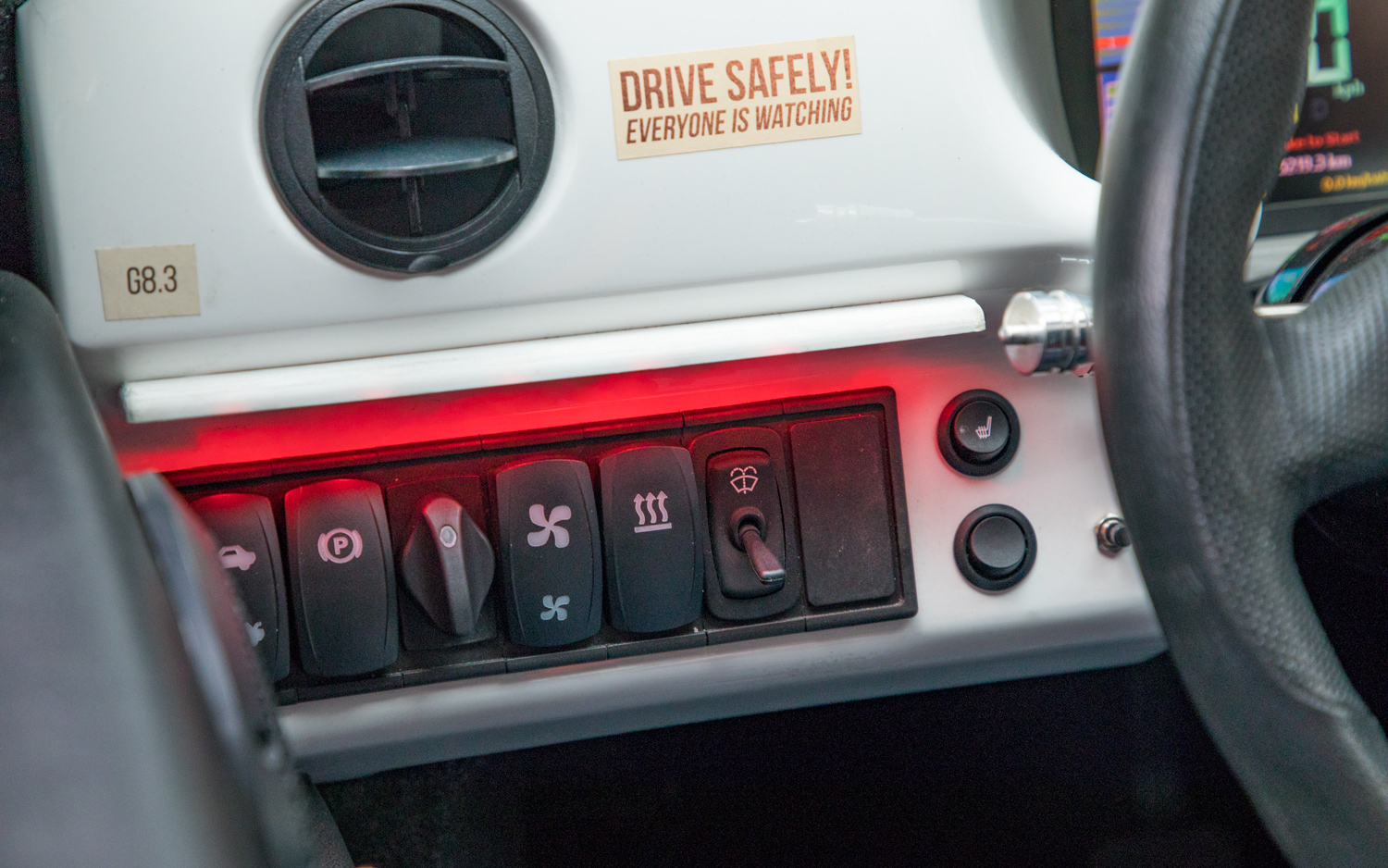
Unfortunately, there are no advanced driver-assistance features, like lane-keeping assist or automatic braking, in the car. The first-generation Solo was designed as a basic electric commuter vehicle, although the company said it is looking forward to adding autonomous and semiautonomous technologies in the future.
The Drive: Some adjustments are necessary
Driving the Solo is a very different experience from driving a traditional compact car. Part of that is because it doesn't use a gas-guzzling combustion engine, and part is due to its unique design.
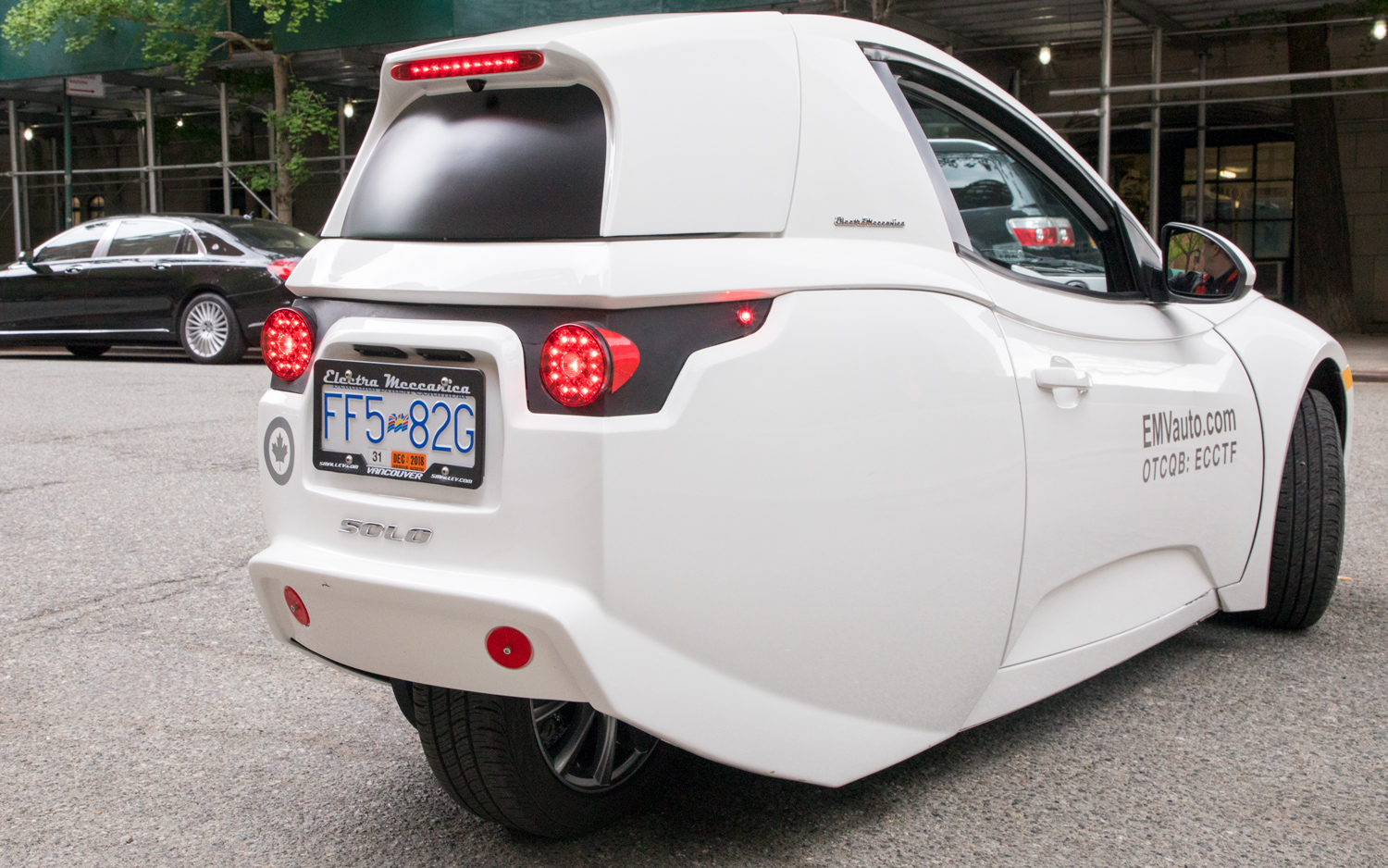
There's no throaty Harley roar from the three-wheeler. Instead, you get quiet electric power — save for when you step on it after a red light to impress pedestrians, when you'll hear a spaceship-like whining noise. Not exactly the stuff of street-racing legend.
On the other hand, there's none of the grinding slowdown that comes with heavy regenerative braking on some EVs. The Solo was designed to behave, at least in this respect, more like a regular car. (I found the braking a little too soft in the preproduction vehicle. The production model promises to be more responsive.)
For most maneuvers, the Solo turns smartly, and you feel like you're in direct contact with the road (in fact, you are). Its turning radius isn't as tight as you might expect, but the Solo can easily perform a U-turn on a suburban street lined with parked cars. At speed, there's a little understeer — again, like what you'll find with most traditional sedans.
Nevertheless, drivers will need to make some adjustments. The lack of a rearview mirror, for example, takes some getting used to. The two side mirrors adequately cover the view behind, but I found it difficult to break the habit of looking up to glance in the (nonexistent) mirror.
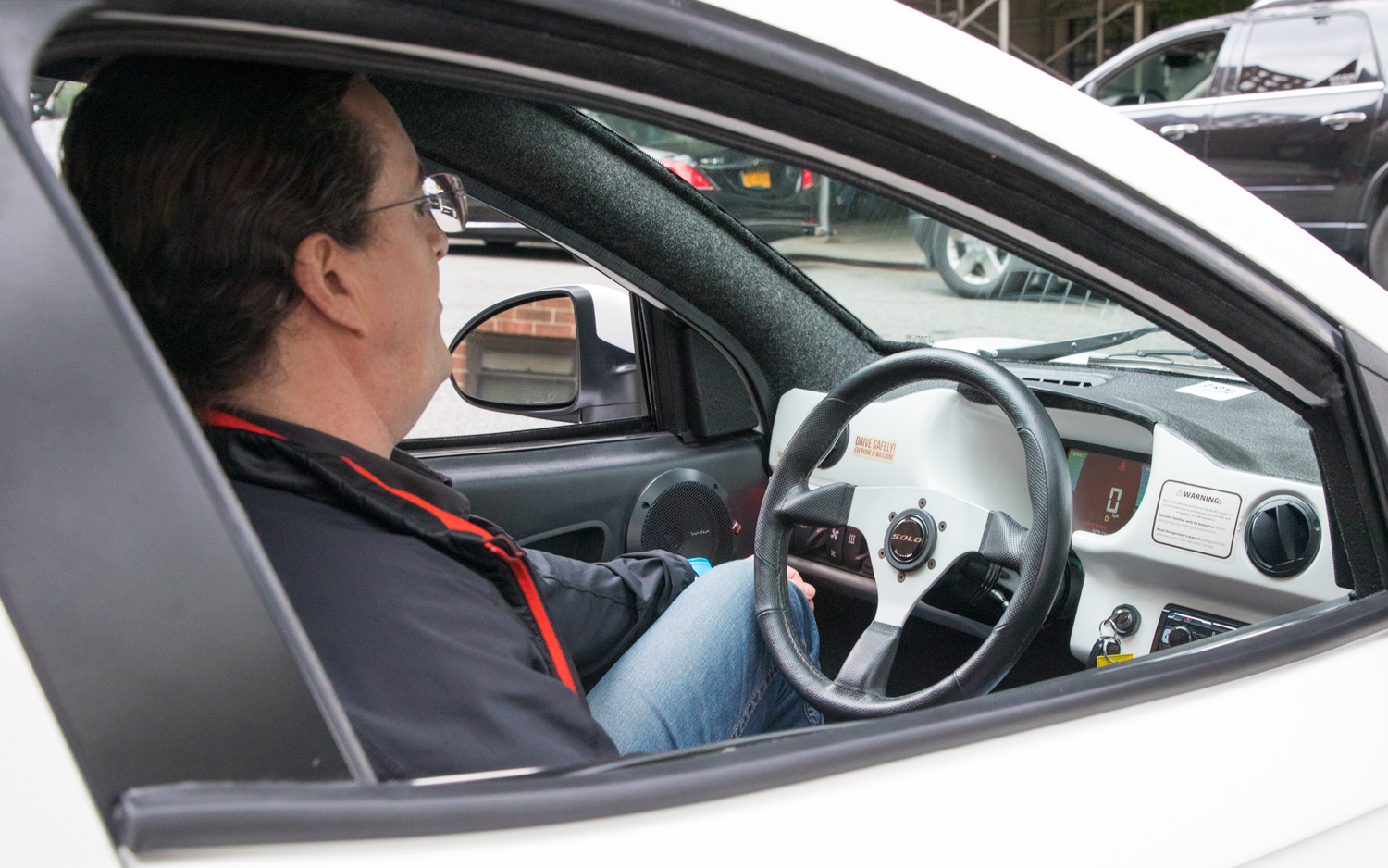
Furthermore, the ride in the Solo is firm, to say the least. This is not a vehicle that glides over potholes. In fact, you'll want to avoid major pavement perturbations as much as possible, and that can take some practice. Once I realized that my back would suffer if I hit another hole in the road, I lined up the next pothole directly between the front wheels in order to sail over it. But, of course, this only centered the hole so that I hit it directly with the rear wheel. After that, I learned how to direct such obstacles to one side or the other.
Electra Meccanica's CEO, Jerry Kroll, said in an interview that the designers were trying to achieve a Mazda Miata-like experience: enough power and agility to have some fun, but not so much that you're going to get yourself into trouble. And that's a pretty apt assessment. The Solo is slower off the mark than a Miata, getting up to 60 mph in 8 seconds versus around 6 for the Miata, but it feels sporty and can handle highways with a rated top speed of 82 mph.
Solo vs. Arcimoto
The Solo invites comparisons to another electric three-wheeler, the Arcimoto, which starts at just under $12,000. With its open, roll-cage-style design, the Arcimoto from the eponymous Eugene, Oregon-based company is more of a beefed-up, three-wheeled electric motorcycle than a slimmed-down electric car.
MORE: Connected Cars: A Guide to New Vehicle Technology
The Arcimoto feels nimbler than the Solo, thanks to its front-wheel-drive system, although its performance specifications are comparable to those of the Solo (including a 70-mile range). And while the Arcimoto has room for a passenger sitting behind the driver, it's less of a practical commuting vehicle because of its open-air concept, compared with the enclosed and protected Solo.
Bottom Line
Delivering more mobility options for urban commuters is always a good thing. The Solo isn't for everybody, but it could be a godsend for many people who find themselves fighting traffic and hunting for parking every day. Most Americans who drive to work do so by themselves and travel less than 40 miles a day, so the Solo makes sense for these commuters. And the single seat means you'll never get roped into having to give someone a lift home.
Credit: Tom's Guide
John R. Quain has been reviewing and testing video and audio equipment for more than 20 years. For Tom's Guide, he has reviewed televisions, HDTV antennas, electric bikes, electric cars, as well as other outdoor equipment. He is currently a contributor to The New York Times and the CBS News television program.
-
MtnFireGuy No mention is made of safety in this article. Due to the weird laws in the US, it is considered a motorcycle and does not have an airbag. Care to guess about survivability in a side impact?Reply
